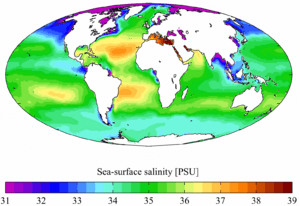Salinity facts for kids
Salinity is a scientific term. Scientists use it to tell how much salt there is in water. Salinity is measured by the amount of sodium chloride found in 1,000 grams of water, if there is 1 gram of sodium chloride in 1,000 grams of water solution it is 1 part per thousand. This is written as 1‰.
- Fresh water contains less than 0.1% of salt . This is the usual case for rivers and lakes.
- Brackish water contains between 0.1% and 3% of salt. This environment is usually found at estuaries where a river flows into the sea.
- Saline water contains between 3% and 5% of salt (per volume). Usually, there is about 3.5% salt in the water of the oceans.
- Water that has more than 5% salt in it, is called brine. Some lakes and bodies of water have that much salt in them. The Dead Sea has about 15% salt (150‰) on the surface.
Images for kids
-
Annual mean sea surface salinity for the World Ocean. Data from the World Ocean Atlas 2009.
See also
 In Spanish: Salinidad para niños
In Spanish: Salinidad para niños

All content from Kiddle encyclopedia articles (including the article images and facts) can be freely used under Attribution-ShareAlike license, unless stated otherwise. Cite this article:
Salinity Facts for Kids. Kiddle Encyclopedia.



